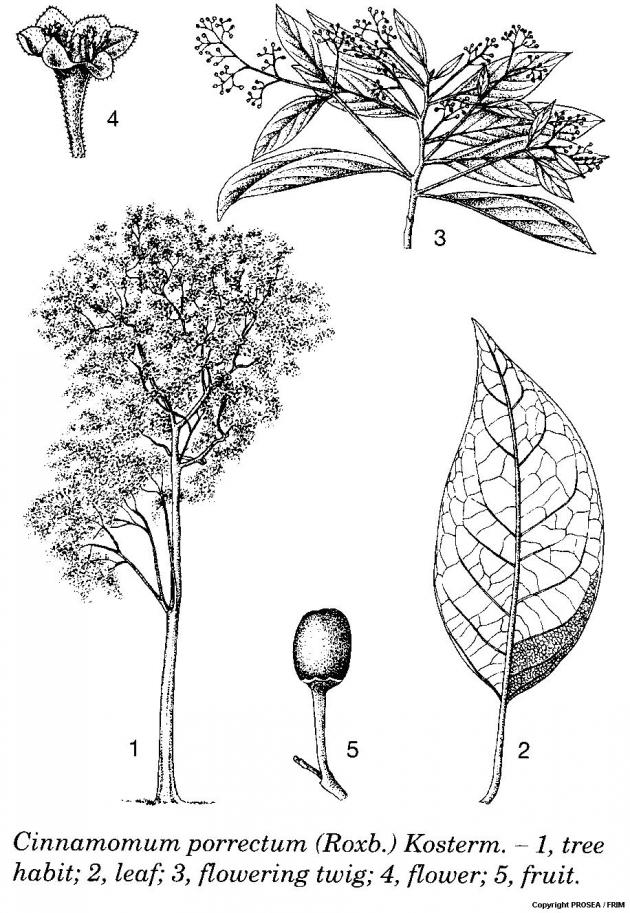Scientific Name
Cinnamomum porrectum (Roxb.) Kosterm.
Synonyms
Camphora chinensis Nees, Camphora inodora Blume ex Miq., Camphora inuncta Nees, Camphora parthenoxylon (Jack) Nees, Camphora porrecta (Roxb.) Voigt, Camphora pseudosassafras Miq., Cinnamomum inodorum (Blume ex Miq.) Meisn., Cinnamomum inunctum (Nees) Meisn., Cinnamomum malaccense Meisn., Cinnamomum neesianum Meisn., Cinnamomum parthenoxylon (Jack) Meisn., Cinnamomum penninervium Kosterm., Cinnamomum pseudosassafras Meisn., Laurus parthenoxylon Jack, Laurus porrecta Roxb., Parthenoxylon porrectum (Roxb.) Blume, Phoebe latifolia Champ. ex Benth., Sassafras parthenoxylon (Jack) Nees [1]
Vernacular Name
| Malaysia | Medang kemangi (Peninsular); keplah wangi (Sarawak); bunsod (Sabah) [2]; kayu gadis, medang gatal, kayu gading, medang serai, medang benar, medang losoh, medang liang, medang lilin, medang lawas, medang besuk, teja, teja lawing, medang kemangi, cinta mula hitam, medang selasoh [3] |
| English | Safrol laurel [2] |
| Indonesia | Medang lesah (General); ki sereh (Sundanese); selasihan (Javanese), rawali (Kalimantan) [2]; selasihan, telasihan, huru pedes, ki pedes, melana, laso [3] |
| Thailand | Thep-tharo (Central) [2] |
| Myanmar | Karawa [2] |
| Vietnam | Re huong [2] |
Geographical Distributions
Cinnamomum porrectum is found in India, Burma (Myanmar), through Indo-China, Thailand and southern China, towards Peninsular Malaysia, Singapore, Sumatra, Java and Borneo. [2] C. porrectum is widely distributed and locally common in lowland to montane forests, sometimes in regions with a pronounced dry season up to 2000 (-3000) m altitude. [2]
Botanical Description
C. porrectum comes from the family of Lauraceae. It is a medium-sized to large, more or less deciduous tree up to 45 m tall. [2]
The bole is straight, cylindrical, measures up to 105 cm in diametre and sometimes buttressed. The surface of the bark is deeply irregularly fissured or cracked, dark grey or greyish-brown while the inner bark is reddish-brown and laminated. [2]
The leaves are subopposite to spiral, measuring 5-15 cm x 2.5-8 cm, with wedge-shaped to rounded base, blunt to acuminate at apex, smooth and with 3-8 pairs of lateral veins. The main veins are prominent above, with reticulate tertiary venation, faint on both surfaces and with petiole 1.2-3 cm long. [2]
The inflorescence is an axillary or pseudo-terminal panicle measuring 2.5-15 cm long. The flowers are smooth or sparingly hairy. [2]
The fruit is spherical to slightly depressed spherical, measuring 0.8-1 cm across, seated on a funnel-shaped perianth cup and with an entire margin. [2]
Cultivation
C. porrectum can grow on both fertile and poor soils, usually in well-drained locations. The density of the wood is 400-860 kg/m3 at 15% moisture content. [2]
Chemical Constituent
No documentation
Plant Part Used
No documentation
Traditional Use
No documentation
Preclinical Data
No documentation
Clinical Data
No documentation
Poisonous Management
No documentation
Line Drawing

References
- The Plant List. Ver1.1. Cinnamomum porrectum (Roxb.) Kosterm.[homepage on the Internet]. c2013 [updated 2012 Mar 23; cited 2015 Apr 28]. Available from: http://www.theplantlist.org/tpl1.1/record/kew-2721550
- Cinnamomum porrectum (Roxb.) Kosterm In: Lemmens RHMJ, Soerianegara I, Wong WC, editors. Plant Resources of South-East Asia No.5(2): Timber trees: Minor Commercial Timbers. Leiden, Netherlands: Backhuys Publishers; 1995.
- Herbal Medicine Research Centre, Institute Medical Research. Compendium of Medicinal Plants Used in Malaysia. Volume 1. Kuala Lumpur: HMRC IMR; 2002. p. 172.


